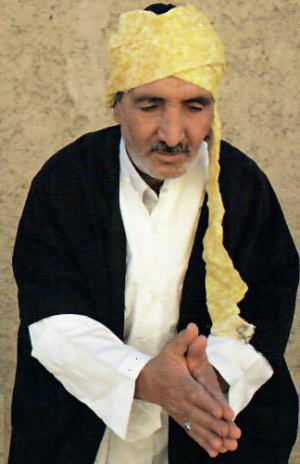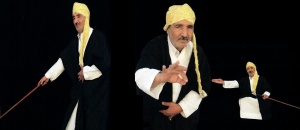Aziz mohammad darvishi: Difference between revisions
T.ramezani (talk | contribs) (Created page with "{{Infobox artist | name = Aziz mohammad darvishi | image = Aziz mohammad darvishi 01.png | image_size = | alt = | caption...") |
mNo edit summary |
||
| Line 13: | Line 13: | ||
| patrons = Morshed Safdar Darvishi (his father) | | patrons = Morshed Safdar Darvishi (his father) | ||
}} | }} | ||
[[fa:عزیز محمد درویشی]] | |||
'''Aziz Mohammad Darvishi''' (born in 1952) is a prominent Iranian [[Pardekhan]] and [[Maddah]] who started Pardekhani when he was six years old. | '''Aziz Mohammad Darvishi''' (born in 1952) is a prominent Iranian [[Pardekhan]] and [[Maddah]] who started Pardekhani when he was six years old. | ||
==Performance Method== | ==Performance Method== | ||
Revision as of 12:02, 17 July 2019
Aziz mohammad darvishi | |
|---|---|
 | |
| Born | 1952 Arak |
| Nationality | Iranian |
| Known for | Pardekhani and Maddahi |
| Patron(s) | Morshed Safdar Darvishi (his father) |
Aziz Mohammad Darvishi (born in 1952) is a prominent Iranian Pardekhan and Maddah who started Pardekhani when he was six years old.
Performance Method
The movement of his body, hands and face is stylized and while being limited is very well adapted to the original mode of performance. Clapping, opening and closing of the fists are used for indicating different meanings such as place and fighting and power washing, kneeling to indicate the faces of those present on the bottom of the curtain are the other particularities of the performances of Morshed Aziz Mohammad Darvishi. The most important quality of his performance is the perfection in adaptation of the narration, chanting and body movement.
Reciting Method
Aziz Mohammad Darvishi uses traditional methods of singing. While narrating the epic he recites war melodies, in the explanation of the adjectives of the Ashqiya (evil characters), he has a tone full of fury and in the description of the condition of the martyrs or prisoners he takes on a lyrical tone. In the darvish curtains the portraits of the two children of Muslim ibn Aqil are always together. Other than these two the images, the illustration of Imam Hasan and Imam Husayn are depicted together in some of the gatherings. The painting of these faces evoke a common culture and destiny. Both the two children and Hasan and Husayn are martyred. In another aspect, some of the angels such as Munkar wa Nakir also are next to each other. Based on their common or parallel duties they need to be shown together. Some others which are shown together or accompanying each other in the curtains are the portraits of the Five, Mohammad the prophet, Imam Ali, Fatima, Imam Hasan, and Imam Husayn. Such congregation may be applicable in other groups, but those mentioned possess historical identity and known reasons for being together on the curtains.
Narration
The story is famous narrative of Do Tiflan-e Muslim, the two children of Muslim who are martyred after great trials and tribulations. The father of the children, Muslim is one of the ambassadors and followers of Imam Husayn (third Imam of Shi'ite) who leads his caravan to Kufa and is killed in the intrigue of the rulers opposing the Imam.
Source
- Ardalan, hamidreza (2008). Picture-storyteller masters of iran, the Iranian academy of the art, 2008, volume 21. ISBN: 978-964-2986-088(vol.21). 978-964-2986-002(set).


